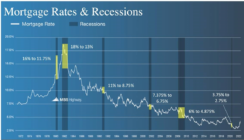
It turns out that most of the retail economy has been running on student loan debt relief.
Who knew?
Unfortunately, that relief is about to end with the payment moratorium ending at the end of the summer and the Supreme Court telling Mr. Biden he can no longer eliminate student loan debt overall with the stroke of a pen.
Macro Analyst Lance Roberts recently wrote an excellent article about the impact of the moratorium ending: Student Loan Repayments – Will It Start the Recession?
Student loan payments were “paused” three years ago at the start of COVID and the pauses (there were extensions) will soon stop for good.
The amount of “relief” this gave to the economy as a whole was staggering.
There is about $1.8 TRILLION of student loan debt outstanding, and most of it is at rates from about 5% to 8%.
The average estimated payment is just under $400 per month, and the total of all monthly payments for Federal student loans is about $16 billion per month.
Almost 16% of American adults owe student loans, with the 25–34-year-old cohort owing the most.
Long story short: All of those young people were spending their student loan relief – primarily at restaurants and stores. And the sudden halting of that relief could really whack the economy.
SIDEBAR: Student loan relief is one reason restaurants and stores have been so busy, but there is another similar reason according to a theory proposed by George Gammon. Young people in the restaurant and service sector, e.g. In-N-Out Burger, have enjoyed tremendous wage gains in recent years while still living at home. So ALL of those gains have been pouring into the restaurant and retail sector too. In other words, if Jr is suddenly making $30,000 per year working part-time while still living at home, he’s going to have a lot of cash to throw around and throw it he will.
What Can Borrowers with Student Loans Do?
While we worry about the economy, we might worry more about individual borrowers because student loan payments are often a major impediment to homebuying!
So, the question is what can borrowers do if their payments are too much to handle OR if they want to buy a house and their student loan payments are preventing them from qualifying?
Borrowers with student loan debt problems should start here: Studentaid.gov
This is the most important resource for borrowers to explore their options.
There is just one application to fill out, and it will pair borrowers up with the best repayment options for all of their loans.
This can be anything from an income-based repayment to partial or full loan forgiveness.
Switching to one of the multiple Income-Driven Repayment (IDR) plans could significantly reduce required loan payments, even down to $0 in some cases!
And, once borrowers join an IDR plan, they can easily switch to another IDR plan as their job and life circumstances change.
They can also consolidate all of their loans into one larger loan, making everything more manageable.
Finally, if borrowers just want to play around with different scenarios, this free Loan Simulator tool can help them run through their options at a high level.
92% Of All Student Loans Are “Federal”
The above option via Studentaid.gov is for Federal student loans – which make up 92% of all student loans.
But – there are some private firms that help with ALL student loans (public and private) – and these firms include the following: Credible; Chipper; Savi; and SoFi.
These firms typically charge subscription fees and offer a lot more handholding, but many borrowers can likely figure everything out on their own via Studentaid.gov.
Cash-Out Refis
Last but not least is the cash-out option for any student loan holder who owns a home already.
Borrowers can pay off student loans with cash out WITHOUT INCURRING THE NORMAL INCREASE TO THE INTEREST RATE THAT COMES WITH MOST CASH-OUT LOANS (about 0.25%).
Turning student loan debt into mortgage debt also (1) spreads out the payments over 30 years; (2) reduces overall payments tremendously – providing massive budget relief; and (3) makes the interest tax deductible in most cases.
























